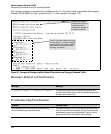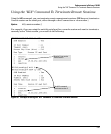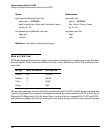
139
Enhancements in Release F.04.08
Configuring Rapid Reconfiguration Spanning Tree (RSTP)
Configuring RSTP
The default switch configuration has Spanning Tree disabled with RSTP as the selected protocol.
That is, when Spanning Tree is enabled, RSTP is the version of Spanning Tree that is enabled, by
default.
Optimizing the RSTP Configuration
To optimize the RSTP configuration on your switch, follow these steps (note that for the Menu
method, all of these steps can be performed at the same time by making all the necessary edits on
the Spanning Tree Operation screen and then saving the configuration changes):
1. Set the switch to support RSTP (RSTP is the default):
CLI: spanning-tree protocol-version rstp
Menu: Main Menu —> 2. Switch Configuration —> 4. Spanning Tree Operation —> select
Protocol Version: RSTP
2. Set the “point-to-point-mac” value to false on all ports that are connected to shared LAN
segments (that is, to connections to hubs):
CLI: spanning-tree [ethernet] <port-list> point-to-point-mac force-false
Menu: Main Menu —> 2. Switch Configuration —> 4. Spanning Tree Operation —> for each
appropriate port, select Point-to-Point: Force-False
3. Set the “edge-port” value to false for all ports connected to other switches, bridges, and hubs:
CLI: no spanning-tree [ethernet] <port-list> edge-port
Menu: Main Menu —> 2. Switch Configuration —> 4. Spanning Tree Operation —> for each
appropriate port, select Edge: No
4. Set the “mcheck” value to false for all ports that are connected to devices that are known to be
running IEEE 802.1D STP:
CLI: no spanning-tree [ethernet] <port-list> mcheck
Menu: Main Menu —> 2. Switch Configuration —> 4. Spanning Tree Operation —> for each
appropriate port, select MCheck: No
5. Enable RSTP Spanning Tree:
CLI: spanning-tree
Menu: Main Menu —> 2. Switch Configuration —> 4. Spanning Tree Operation —> select
STP Enabled: Yes


















